Toyota RAV4 1997 Owner Manual
Part 1 OPERATION OF INSTRUMENTS AND CONTROLSÐ
Chapter 1-1
Overview of instruments and controls
Instrument panel overview
Instrument cluster overview
Indicator symbols on the instrument panel
1
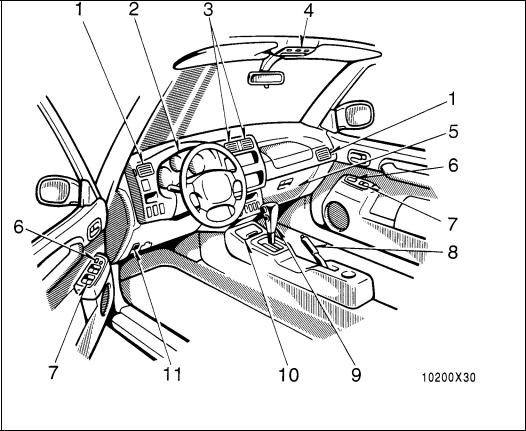
Instrument panel overview
1. Side vent
2. Instrument cluster
3. Center vents
4. Electronic moon roof switch and personal lights
5. Glovebox
6. Power door lock switch
7. Power window switches
8. Parking brake lever
9. Automatic transmission selector lever or manual transmission gear shift lever
10. Ashtray
11. Hood lock release lever
2
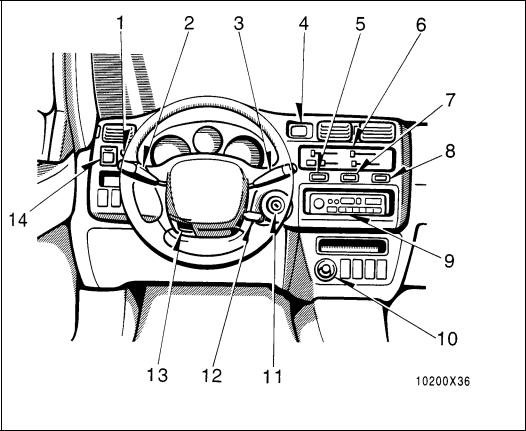
1.Instrument panel light control knob
2.Headlight and turn signal switch
3.Wiper and washer switch
4.Clock
5.Center differential lock button or driving pattern selector buton
6.Air conditioning controls
7.Emergency flasher switch
8.Rear window defogger switch
9.Car audio
10.Cigarette lighter
11.Ignition switch
12.Cruise control switch
13.Tilt steering lock release lever
14.Power rear view mirror control switch
3
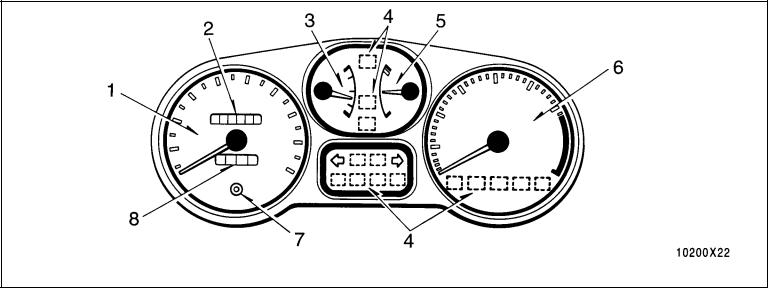
Instrument cluster overview
1. |
Speedometer |
4. |
Service reminder indicators or |
7. |
Trip meter reset knob |
2. |
Odometer |
|
indicator lights |
8. |
Trip meter |
3. |
Fuel gauge |
5. |
Engine coolant temperature gauge |
|
|
|
|
6. |
Tachometer |
|
|
4
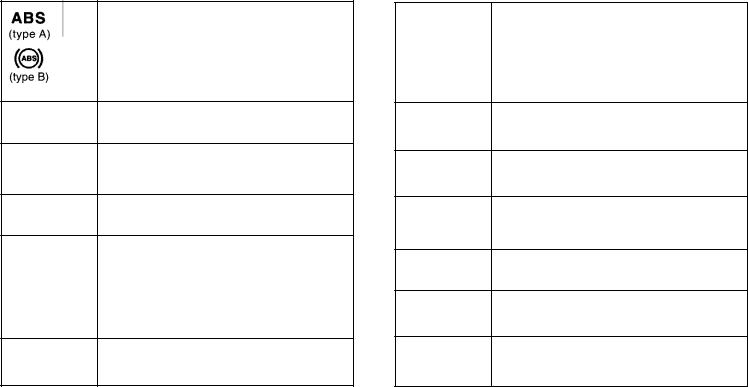
Indicator symbols on the instrument panel
Brake system warning light *1
Seat belt reminder light*1
Discharge warning light*1
Low oil pressure warning light*1
Malfunction indicator light*1
Low fuel level warning light *1
Anti-lock brake system warning light *1
Open door warning light*1
SRS airbag warning light*1
Automatic transmission fluid temperature warning light*1
Turn signal indicator lights
Headlight high beam indicator light
Over-drive indicator light
5
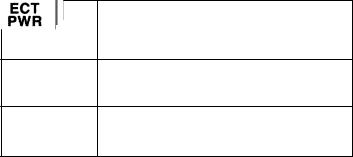
Driving pattern indicator light
Center differential lock indicator light
Cruise control indicator light *2
*1: For details, see “Service reminder indicators and warning buzzersº in Chapter 1-5.
*2: If this light flashes, see “Cruise controlº in Chapter 1-6.
6
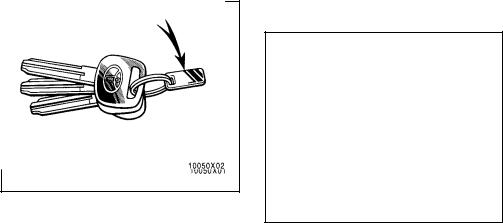
Part 1 OPERATION OF
INSTRUMENTS AND CONTROLSÐ
Chapter 1-2
Keys and Doors
Keys
Side doors
Power windows
Quarter window
Back door
Hood
Fuel tank cap
Electric moon roof
Detachable sun roof
Keys
Your vehicle is supplied with two kinds of key.
1.Master keyThis key works in every lock.
2.SubkeyThis key will not work in the glovebox.
To protect things locked in the glovebox when you have your vehicle parked, leave the subkey with the attendant.
Since the side doors and back door can be locked without a key, you should always
carry a spare key in case you accidentally lock your keys inside the vehicle.
KEY NUMBER PLATE
Your key number is shown on the plate. Keep the plate in a safe place such as your wallet, not in the vehicle.
If you should lose your keys of if you need additional keys, duplicates can be made by a Toyota dealer using the key number.
You should also put a copy of the key number with your important papers.
7
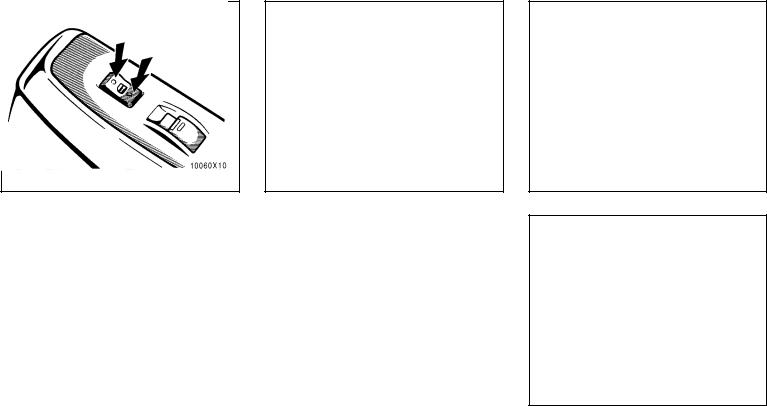
Side doors
LOCKING AND UNLOCKING WITH KEY
Insert the key into the keyhole and turn it.
To lock: Turn the key downward. To unlock: Turn the keyupward.
Vehicles with power door lock systemÐAll side doors and back door lock and unlock simultaneously with either front door. In the driver's door lock, turning the key once will unlock the driver's door and twice in succession will unlock all the side doors and back door simultaneously.
LOCKING AND UNLOCKING WITH INSIDE LOCK BUTTON
Move the lock button.
To lock: Push the button downward. To unlock: Pull the button upward.
Closing the door with the lock button pushed in will also lock the door. Be careful not to lock your keys in the vehicle.
Driver's side
Passenger's side
8
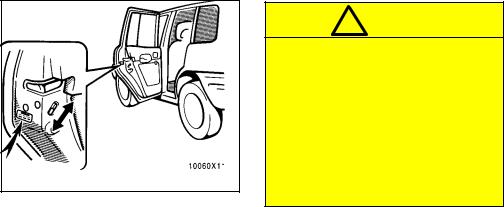
LOCKING AND UNLOCKING WITH
POWER DOOR LOCK SWITCH
Push the switch.
To lock: Push the switch on the front side.
To unlock: Push the switch on the rear side
Operating the switch simultaneously locks or unlocks all the side doors and the back door.
REAR DOOR CHILD-PROTECTORS
Move the lock lever to the “LOCKº position as shown on the label.
This feature allows you to lock a rear door so it can be opened from the outside only, not from inside. We recommend using this feature whenever small children are in the vehicle.
! CAUTION
Before driving, be sure that the doors are closed and locked, especially when small children are in the vehicle. Along with the proper use of seat belts, locking the doors helps prevent the driver and passengers from being thrown out from the vehicle during an accident. It also helps prevent the doors from being opened unintentionally.
9

Power windows
The windows can be operated with the switch on each door.
The power windows work when the ignition switch is in the “ONº position. However, if both doors are closed, they work for 45 seconds even after the ignition switch is turned off. They stop working when either door is opened.
OPERATING THE DRIVER'S WINDOW
Use the switch on the driver's door.
Normal operation: The window moves as long as you hold the switch.
To open: Lightly push down the switch. To close: Pull up the switch.
Automatic operation (to open only):
Push the switch completely down and then release it. The window will fully open. To stop the window partway, lightly pull the switch up and then release it.
OPERATING THE PASSENGERS' WINDOWS
Use the switch on each passengers' door or the switches on the dirver's door that control each passengers' window.
The windows move as long as you hold the switch.
To open: Push down the switch. To close: Pull up the switch.
If you push in the window lock button on the driver's door, the passenger's windows cannot be operated.
10
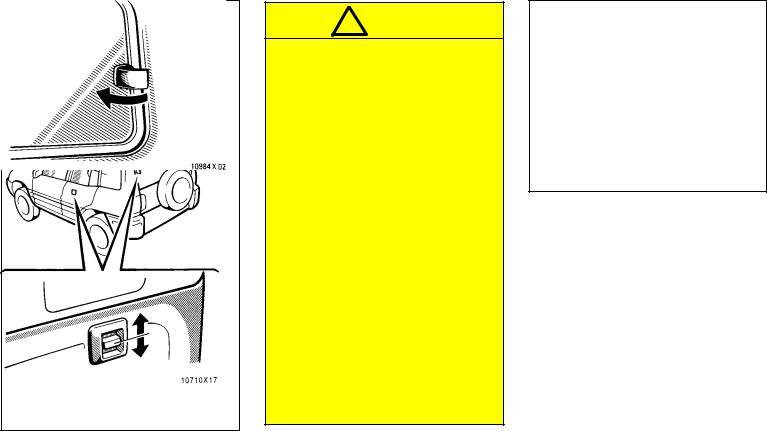
! CAUTION
To avoid serious personal injury, you must do the following.
Always make sure the head, hands and other parts of the body of all occupants are kept completely inside the vehicle before you close the power windows. If someone's neck, head or hands gets caught in a closing window, it could result in a serious injury. When anyone closes the power windows, be sure that they operate the windows safely.
When small children are in the vehicle, never let them use the power window switches without supervision. Use the “WINDOW LOCKº button to prevent them from making unexpected use of the switches.
Never leave small children alone in the vehicle, especially with the ignition key still inserted. They could use the power window switches and get trapped in a window. Unattended children can become involved in serious accidents.
Quarter window
(right side onlyÐ2-door models)
To open the quarter window, pull the latch handle toward you and swing it fully out.
When closing the window, make sure it is completely closed.
11
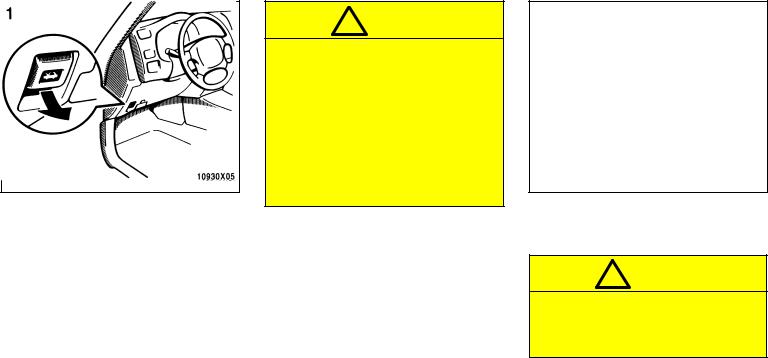
Back door
LOCKING AND UNLOCKING WITH KEY
Insert the key into the keyhole and turn it.
To lock: Turn the key counterclockwise. To unlock: Turn the key clockwise. When closing the backdoor, make sure it is fully closed.
See “Luggage stowage precautionsº in Part 2 for precautions to observe in loading luggage.
!CAUTION
Keep the back door closed while driving. This not only keeps the luggage from being thrown out but also prevents exhaust gases from entering the vehicle.
If the open back door hides the rear stop and tail lights or rear turn signal lights while you are parked, other road users must be warned of the presence of your vehicle by a warning triangle or other device.
Hood
To open the hood, do the following.
1.Pull the hood lock release lever. The hood will spring up slightly.
!CAUTION
Before driving, be sure that the hood is securely locked. Otherwise, the hood may open unexpectedly while driving and an accident may occur.
12
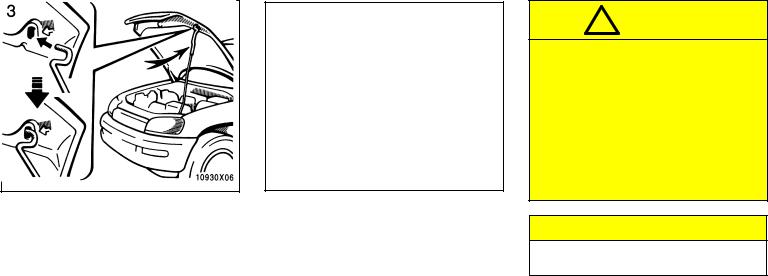
2.In front of the vehicle, pull up on the auxiliary catch lever and lift the hood.
3.Hold the hood open by inserting the support rod into the slot.
Before closing the hood, check that you have not forgotten any tools, rags, etc. and return the support rod to its clip-this prevents rattles. Then lower the hood until it is about 20 cm (8 in.) above the engine compartment and release it. If the hood is still not fully closed, lift and release the hood again. After closing the hood, make sure it is securely locked.
If you notice while driving that the hood is not securely locked, stop the vehicle at once and close the hood.
!CAUTION
Right after driving the support rod may be hot, so only touch the part coated with nylon.
After inserting the rod into the slot, make sure the rod supports the hood securely from falling down on to your head or body.
When closing the hood, be careful not to get your hands caught between the hood and the vehicle body.
NOTICE
Do not press on the hood, or you may deform the hood.
13
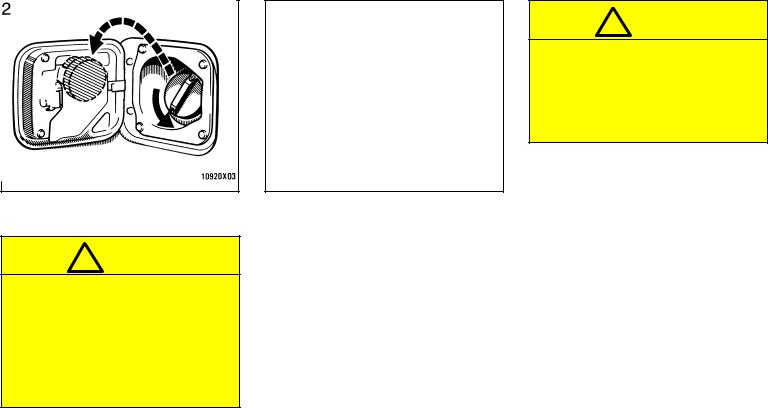
Fuel tank cap
1.To open the fuel filler door, pull the lever up.
!CAUTION
Do not smoke, cause sparks or allow open flames when refuelling. The fumes are flammable.
When opening the cap, do not remove the cap quickly. In hot weather, fuel under pressure could cause injury by spraying out of the filler neck if the cap is suddenly removed.
2.To remove the fuel tank cap, turn the cap slowly counterclockwise, then pause slightly before removing it. After removing the cap, hang it on the cap hanger.
It is not unusual to hear a slight swoosh when the cap is opened. When installing, turn the cap clockwise till you hear a click.
If the cap is not tightened securely, the malfunction indicator lamp comes on. Make sure the cap is tightened securely.
The indicator lamp goes off after driving several times. If the indicator lamp does not go off, contact your Toyota dealer as soon as possible.
!CAUTION
Make sure the cap is tightened securely to prevent fuel spillage in case of an accident.
Use only a genuine Toyota fuel tank cap for replacement. It has a built in check valve to reduce fuel tank vacuum.
14

Electric moon roof
Sliding operation
Tilting operation
To operate the moon roof, use the switches beside the personal light.
The key must be in the “ONº position. Sun shade operationÐ
The sun shade can be opened or closed by hand.
Sliding operationÐ
To open: Push the switch on the “SLIDEº side.
The sun shade will be opened together with the roof.
To close: Push the switch on the opposite side of the “SLIDEº side.
As a precaution when closing, the roof stops at the three-quarters closed position before fully closing. Therefore, release the switch and then push it again to close it completely.
Tilting operationÐ
To tilt up: Push the switch on the “UPº side.
To lower: Push the switch on the opposite side of the “UPº side.
You may stop the moon roof at any desired position. The roof will move while the switch is being pushed and stop when released.
!CAUTION
To avoid serious personal injury, you must do the following.
While the vehicle is moving, always keep the head, hands and other parts of the body of all occupants away from the roof opening. Otherwise, you could be seriously injured if the vehicle stops suddenly or if the vehicle is involved in an accident.
Always make sure nobody places his/her head, hands and other parts of the body in the roof opening before you close the roof. If someone's neck, head or hands gets caught in the closing roof, it could result in a serious injury. When anyone close the roof, first make sure it is safe to do so.
Never leave small children alone in the vehicle, especially with the ignition key still inserted. They could use the power window switches and get trapped in a window. Unattended children can become involved in serious accidents.
15
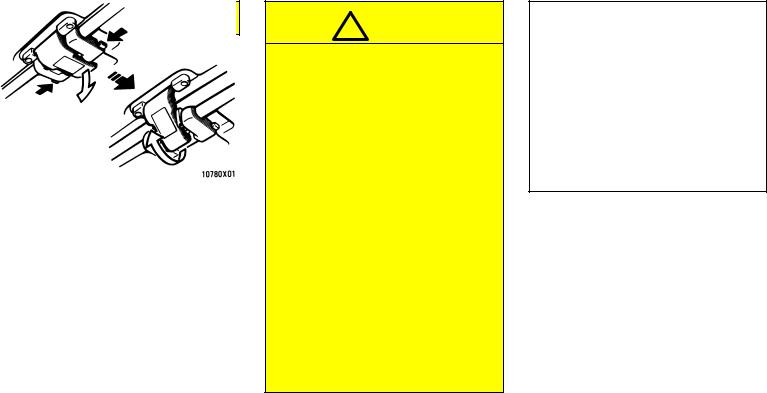
Never sit on top of the vehicle around the roof opening.
Detachable sun roofÐ
ÐSun roof precautions
!CAUTION
To avoid serious personal injury, you must do the following.
While the vehicle is moving, always keep the head, hands and other parts of the body of all occupants away from the roof opening. Otherwise, you could be seriously injured if the vehicle stops suddenly or if the vehicle is involved in an accident.
Never sit on top of the vehicle around the roof opening.
Never attempt to remove the sun roof panels while driving. Otherwise, the panels may become a hazard by falling into or flying off the vehicle.
After installing the sun roof panel, make sure they are firmly secured by pushing up on the underside of each panel.
Never put your hands between the sun roof panel and the surrounding roof.
ÐTilting up and closing
(front only)
To tilt up the sun roof, first pull down on the handle while pushing in one of the lock buttons. Then push up the sun roof until it locks.
The rear sun roof can only be removedÐit is not designed for tilting up.
After tilting up the sun roof, make sure the handle is securely in place.
When closing the sun roof, slowly pull down the handle while supporting the roof with your hand. Close and lock the sun roof by pushing the handle until it clicks. Be sure to use your palm to push the handle. After closing the sun roof, make sure it is securely locked.
16

ÐRemoving
1.Pull the handle down while pushing in one of the lock buttons.
2.Push in the retaining spring arms as shown and push up the sun roof.
3.Push back the auxiliary catch to release it from the hook. Then lift the sun roof panel and pull it out.
17
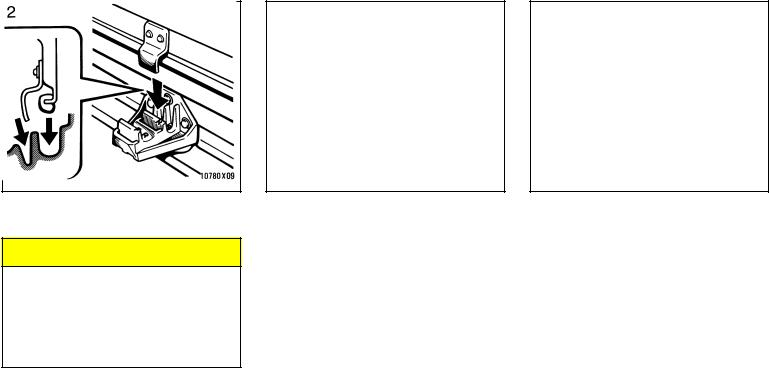
ÐStowing
Install the removed sun roof panels on the back door as follows.
NOTICE
If the rear seats are reclined, return them to the upright position before closing the back door. Otherwise, they will interfere with the installed sun roof panels, possibly damaging them.
1.Remove the holder from the back door by turning the bolts counterclockwise.
The upper holder is for the front sun roof panel and the lower one is for the rear panel.
2.Set the front edge of the sun roof panel into the holders.
The fore part of holders is for the front sun roof panel and the back part is for the rear panel.
18
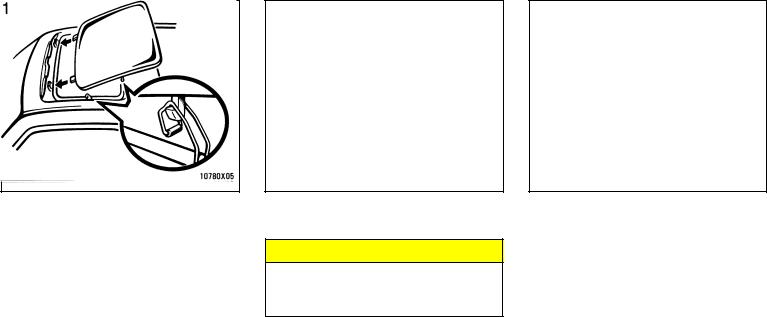
ÐInstalling
3.Place the removed holder over the sun roof handle.
4.Secure the holder by turning the bolts clockwise.
NOTICE
Do not drive the vehicle without checking that the roof panels are securely attached to the back door.
1.Insert the flat hinges of the sun roof panel into the hinge cases on the body. Then slowly lower it while holding the roof with your hands.
Make sure both flat hinges are inserted into the hinge cases.
19
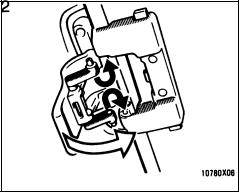
2.Press in the retaining spring arms and insert them into the holes. Then lock the sun roof by pushing the handle up with the palm of your hand until the handle clicks.
20
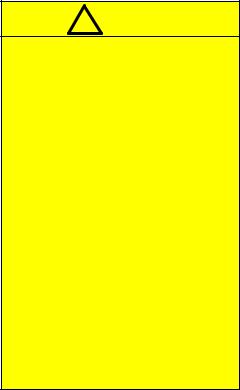
Seat belts-
-Seat belt precautions
Toyota strongly urges that the driver and passengers in the vehicle be properly restrained at all times with the seat belts provided. Failure to do so could increase the chance of injury and/or the severity of injury in accidents.
Child. Use a child restraint system appropriate for the child until the child becomes large enough to properly wear the vehicle's seat belts. See “Child restraintº for details.
If a child is too large for a child restraint system, the child should sit in the rear seat and must be restrained using the vehicle's seat belt. According to accident statistics, the child is safer when properly restrained in the rear seat than in the front seat.
If a child must sit in the front seat, the seat belts should be worn properly. If an accident occurs and seat belts are not worn properly, the force of the rapid inflation of the airbag may cause serious injury to the child.
Do not allow the child to stand up or kneel on either rear or front seats. An unrestrained child could suffer serious injury during emergency braking or a collision. Also, do not let the child sit on your lap. It does not provide sufficient restraint.
If the shoulder belt falls across the child's neck or face:
2-door models-
Have the child sit slightly closer to the center of the vehicle so that the belt lays across the shoulder.
4-door models-
Move the child to the center position and use the center lap belt.
Pregnant woman. Toyota recommends the use of a seat belt. Ask your doctor for specific recommendations. The lap belt should be worn securely and as low as possible over the hips and not on the waist.
Injured person. Toyota recommends the use of a seat belt. Depending on the injury, first check with your doctor for specific recommendations.
!CAUTION
Persons should ride in their seats properly wearing in their seat belts whenever the vehicle is moving. Otherwise, they are much more likely to suffer serious bodily injury in the event of sudden braking or a collision.
When using the seat belts, observe the following:
Use the belt for only one person at a time. Do not use a single belt for two or more people-even children.
Avoid reclining the seatbacks too much. The seat belts provide maximum protection when the seatbacks are in the upright position. (Refer to the seat adjustment instructions.)
Be careful not to damage the belt webbing or hardware. Take care that they do not get caught or pinched in the seat or side doors.
30
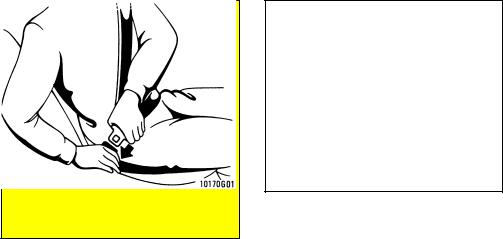
Inspect the belt system periodically. Check for cuts, fraying and loose parts. Damaged parts should be replaced. Do not disassemble or modify the system.
Keep the belts clean and dry. If they need cleaning, use a mild soap solution or lukewarm water. Never use bleach, dye, or abrasive cleaners-they may severely weaken the belts.
Replace the belt assembly (including bolts) if it has been used in a severe impact. The entire assembly should be replaced even if damage is not obvious.
ÐFront seat belts and rear
outside seat belts
Adjust the seat as needed (front seats only) and sit up straight and well back in the seat. To fasten your belt, pull it out of the retractor and insert the tab into the buckle.
You will hear a click when the tab locks into the buckle.
The seat belt length automatically adjusts to your size and the seat position.
The retractor will lock the belt during a sudden stop or on impact. It also may lock if you lean forward too quiclky. A slow, easy motion will allow the belt to extend, and you can move around freely.
If the seat belt cannot be pulled out of the retractor, firmly pull the belt and release it. You will then be able to smoothly pull the belt out of the retractor.
When a passenger's shoulder belt is completely extended and is then retracted even slightly, the belt is locked in that position and cannot be extended. This feature is used to hold the child restraint system securely. (For details, see “Child restraintº in this chapter.) To free the belt again, fully retract the belt and then pull the belt out once more.
31

!CAUTION
After inserting the tab, make sure the tab and buckle are locked and that the belt is not twisted.
Do not insert coins, clips, etc. in the buckle as this may prevent you from properly latching the tab and buckle.
If the seat belt does not function normally, immediately contact your Toyota dealer. Do not use the seat until the seat belt is fixed. It cannot protect an adult occupant or your child from injury.
Seat belts with an adjustable shoulder anchorÐ
Adjust the shoulder anchor position to your size.
To adjust the anchor position, pull the knob out and slide it up or down. Release the knob and make sure the anchor is locked in position.
!CAUTION
Always make sure the shoulder belt is positioned across the center of your shoulder. The belt should be kept away from the neck, but not falling off your shoulder. Failure to do so could reduce the amount of protection in an accident and cause severe injuries in a collision.
32

Adjust the position of the lap and shoulder belts.
Position the lap belt as low as possible on your hips-not on your waist, then adjust it to a snug fit by pulling the shoulder portion upward through the latch plate.
!CAUTION
High-positioned lap belts and loose-fitting belts both could cause severe injuries due to sliding under the lap belt during a collision. Keep the lap belt positioned as low on hips as possible.
For your safety, do not place the shoulder belt under your arm.
To release the belt, press the bucklerelease button and allow the belt to retract.
If the belt does not retract smoothly, pull it out and check for knicks or twists. Then make sure it remains untwisted as it retracts.
33

ÐRear center seat belt
(4-door models)
Sit up straight and well back in the seat. To fasten your belt, insert the tab into the buckle.
You will hear a click when the tab locks into the buckle.
If the belt is not long enough for you, hold the tab at a right angle to the belt and pull on the tab.
!CAUTION
After inserting the tab, make sure the tab and buckle are locked and that the belt is not twisted.
Do not insert coins, clips, etc. in the buckle as this may prevent you from properly latching the tab and buckle.
If the seat belt does not function normally, immediately contact your Toyota dealer. Do not use the seat until the seat belt is fixed. It cannot protect an adult occupant or your child from injury.
Remove excess length of the belt and adjust the belt position.
To shorten the belt, pull the free end of the belt.
Position the lap belt as low as possible on your hips-not on your waist, then adjust it to a snug fit.
!CAUTION
High-positioned and loose-fitting lap belts could cause severe injuries due to sliding under the lap belt during a collision. Keep the lap belt positioned as low on hips as possible.
34

To release the belt, press the bucklerelease button.
ÐStowing the rear seat belts
(4-door models)
The rear seat belts can be stowed when not in use.
Seat belts must be stowed before you fold the seatback. (See “Rear seats-Folding up rear seatsº in this chapter.)
ÐSeat belt extender
If your seat belt cannot be fastened securely because it is not long enough, a personalized seat belt extender is available from your Toyota dealer free of charge.
Please contact your local Toyota dealer so that the dealer can order the proper required length for the extender. Bring the heaviest coat you expect to wear for proper measurement and selection of length. Additional ordering information is available at your Toyota dealer.
35
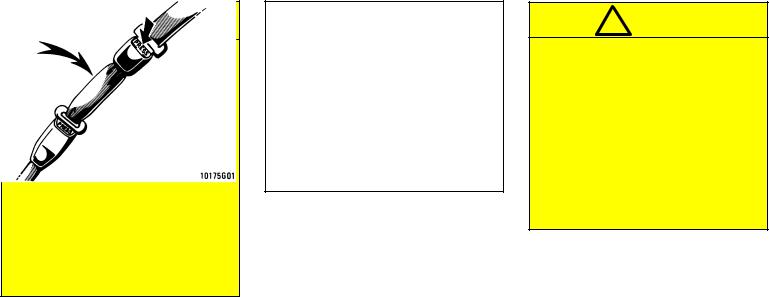
!CAUTION
When using the seat belt extender, observe the following. Failure to follow these instructions could result in less effectiveness of the seat belt restraint system in case of vehicle accident, increasing the chance of personal injury.
Never use the seat belt extender if you can fasten the seat belt without it.
Remember that the extender provided for you may not be safe when used on a different vehicle, or for another person or at a different seating position than the one originally intended for.
To connect the extender to the seat belt, insert the tab into the seat belt buckle so that the “PRESSº signs on the buckle-release buttons of the extender and the seat belt are both facing outward as shown.
You will hear a click when the tab locks into the buckle.
When releasing the seat belt, press on the buckle-release button on the extender, not on the seat belt. This helps prevent damage to the vehicle interior and extender itself.
When not in use, remove the extender and store in the vehicle for future use.
!CAUTION
After inserting the tab, make sure the tab and buckle are locked and that the belt is not twisted.
Do not insert coins, clips, etc. in the buckle as this may prevent you from properly latching the tab and buckle.
If the seat belt does not function normally, immediately contact your Toyota dealer. Do not use the seat until the seat belt is fixed. It cannot protect an adult occupant or your child from injury.
36

SRS airbags
The SRS (Supplemental Restraint System) airbags are designed to provide further protection to the driver and front passenger when added to the primary protection provided by the seat belts.
In response to a severe frontal impact, the SRS airbags work together with the seat belts to help preventing or reduce injury by inflating, in order to decrease the likelihood of the driver's or front passenger's head or chest directly hitting the steering wheel or dashboard. The passenger airbag is activated even with no passenger in the front seat.
This indicator comes on when the ignition key is turned to the “ACCº or “ONº position. It goes off after about 6 seconds. This means the SRS airbags are operating properly.
The SRS airbag warning light system monitors the airbag sensor assembly, inflators, warning light, interconnecting wiring and power sources.
The SRS airbag system is designeed to activate in response to a severe frontal impact within the shaded area between the arrows in the illustration.
The SRS airbags will deploy if the severity of the impact is above the designed threshold level, comparable to an approximate 20 km/h (14 mph) collision when impacting straight into a fixed barrier that does not move or deform.
If the severity of the impact is below the above threshold level, the SRS airbags may not deploy.
37
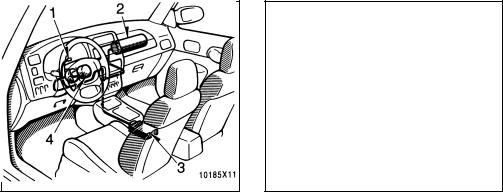
However, this threshold velocity will be considerably higher if the vehicle strikes an object, such as a parked vehicle or sign pole, which can move or deform on impact, or if it is involved in an underride collision (e.g. a collision in which the noise of the vehicle “underridesº, or goes under, the bed of a truck.
It is possible with collision severity at the marginal level of airbag sensor detection and activation that only one of your vehicle's two airbags will deploy.
For the safety of all occupants, be sure to
always wear seat belts.
The SRS airbags are not designed to inflate if the vehicle is subjected to a side or rear impact, if it rolls over, or if it is involved in a low-speed frontal collision.
The SRS airbag system mainly consists of the following components and their locations are shown in the illustration.
1SRS airbag warning light.
2Passenger airbag module (airbag and inflator)
3Airbag sensor assembly.
4Steering wheel pad (airbag and inflator)
The airbag sensor assembly consists of a safing sensor and airbag sensor.
38
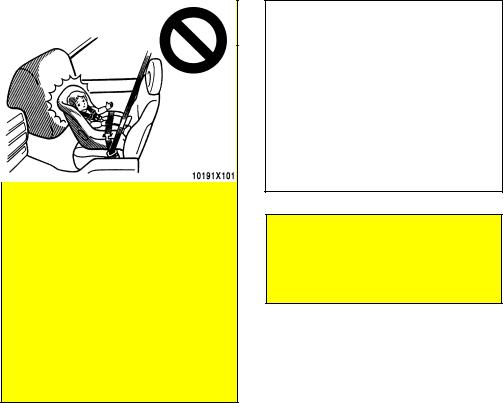
In a severe frontal impact, sensors detect deceleration and the system triggers the airbag inflators. Then a chemical reaction in the inflators momentairly fills the airbags with non-toxic nitrogen gas to help restrain the forward motion of the occupants.
When the airbags inflate, they produce a fairly loud noise and release some smoke along with the nitrogen gas. This is not harmful and does not indicate a fire. Be sure to wash off any residue as soon as possible to prevent minor skin irritation.
Deployment of the airbags happen in a fraction of a second, so the airbags must inflate with considerable force. While the system is designed to reduce serious injuries, it may also cause minor burns or abrasions and swellings.
Parts of the airbag module (steering wheel hub, dashboard) may be hot for several minutes, but the airbags themselves will not be hot. The airbags are designed to inflate only once.
A crash severe enough to inflate the airbags may break the windshield as the vehicle buckles. In vehicles with a passenger airbag the windshield may also be damaged by absorbing some of the force of the inflating airbag.
!CAUTION
The SRS airbag system is designed only as a supplement to the primary protection of the driver side and front passenger side seat belt systems. The front seat occupants are particularly susceptable to death or serious injury if they do not wear their seat belts; when sudden braking or a collision occurs, they may be thrown forward into deployed SRS airbags. To obtain maximum protection in an accident, the driver and all passengers in the vehicle should always wear their seat belts when driving because death or serious injuries can result to unrestrainted occupants. For instructions and precautions con-
cering the seat belt systems, see “Seat beltsº in this chapter.
A baby or small child who is too small to use a seat belt should be properly secured in a rear seat using a child restraint system.
Never put a rear-facing child restraint system in the front seat because the force of the rapid inflation of the passenger airbag can cause death or serious injury to the child.
39
